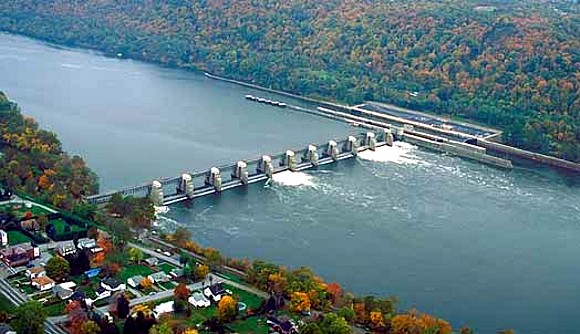Looking to increase renewable energy production at a lower cost to both taxpayers and the environment, the U.S. Department of Energy has come out with a study detailing the potential for retrofitting current non-hydropower dams with the technology needed to produce electric power.
 Ranking 24th in the Oak Ridge survey of potential hydropower sites is the non-powered Montgomery (Ala.) Locks & Dam, spanning the Ohio River near Monaca, Pa. Built in the 1930s to increase the navigational depth of a shallow part of the river, this site has the potential to generate nearly 100 MW of electricity. Caption information and photo courtesy of ecology.com.
Ranking 24th in the Oak Ridge survey of potential hydropower sites is the non-powered Montgomery (Ala.) Locks & Dam, spanning the Ohio River near Monaca, Pa. Built in the 1930s to increase the navigational depth of a shallow part of the river, this site has the potential to generate nearly 100 MW of electricity. Caption information and photo courtesy of ecology.com.
The study found that among the major benefits to these retrofits would be that the monetary costs and environmental impacts of dam construction have already been incurred, so adding power to existing dams can often be achieved at lower costs, with less risk, and in a shorter timeframe than building new dams.
The study estimates that without building a single new dam, these resources – if fully developed – can produce an electric generating capacity of over 12 gigawatts (GW), equivalent to about 15 percent of the country’s current hydropower power, according to the energy department.
To give some perspective, right now in the United States there are about 2,500 dams that provide about 78 GW of conventional hydropower and 22 GW of pump-storage hydropower, but there are more than 80,000 non-power producing dams around the country.
These non-power producing dams are used for purposes such as water supply, flood control, inland navigation locks, and recreation. Of these, the most potential is concentrated in just 100 dams, “which could contribute approximately 8 GW of clean, reliable hydropower; the top 10 facilities alone could add up to 3 GW of new hydropower,” said the study.
All of the top 10 non-power producing dams are U.S. Army Corps of Engineers facilities, which include navigation locks on the Ohio River, Mississippi River, Alabama River, and Arkansas River.
The study also shows promise that dams owned by the U.S. Bureau of Reclamation “hold the potential to add approximately 260 MW of capacity.”
Among the factors looked at in this study to determine the viability of a dam for conversion to a hydropower dam were precipitation leading to streamflow, evaporation rates, ground filtration, and other internal hydrologic processes.
Looking at hydropower potential of different regions, the Northeast and the Great Lakes both have some of the richest attributes including high precipitation and abundant runoff. They also have higher altitudes and cooler temperatures, which reduce evaporation.
Most of the potential dam sites for retrofitting to hydropower are found in the northeastern U.S., in the Ohio River Basin, the Upper and Lower Mississippi River Basins, and the Arkansas-White-Red River Region.
Specifically, some of the highest potentials (because of their streamflow magnitudes) are in the Army Corp of Engineers locks and dams – 87 sites with a total potential of 6.9 GW. The study adds that another benefit is that, “Because locks and dams were mainly built for navigation purposes instead of municipal water supply and irrigation, there may be less concern about impacts regarding other competing water usage.”
In an overview, the study found that “the greatest amount of hydropower potential is found in Alabama, Arkansas, Illinois, Kentucky, Pennsylvania, Texas, and Louisiana; this mainly due to the series of Ohio River locks and high river flows. Many of the Ohio River locks are with within the top 10 list of potential non-powered dam sites.”
Some other information to keep in mind is that the analysis did not consider the economic feasibility of retrofitting each dam to generate hydropower.
This assessment is meant to provide preliminary information for groups – including developers, municipal planners and policymakers – who can further evaluate the potential to develop hydropower in these dam sites.
Additional Resources
Reader comments and input are always welcomed!